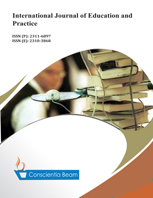Development of a Rating Scale for Measuring Teacher Classroom Autonomy in Secondary Schools in Southwestern Nigeria
DOI:
https://doi.org/10.18488/journal.61/2016.4.4/61.4.134.147Abstract
The study developed Teacher Classroom Autonomy Scale (T-CARS) and estimated the validity and reliability of the scale as well as establishing the scale factor structure. The study adopted a survey design. The population comprised secondary school teachers in southwestern Nigeria and a sample of 1440 teachers that were selected from 72 secondary schools using multistage sampling procedure. Two instruments, T-CARS and School Participant Empowerment Scale (SPES) were used for data collection. Data were analysed using factor analysis and reliability analysis. The results showed that the 40-items T-CARS have seven factors of teacher classroom autonomy that accounted for 91.46% of the total scale variance and significantly converge with the SPES (r = 0.611). The internal consistency of the scale was r=0.913 (Cronbach), and r=0.736 (Spearman Split-half), p< 0.05. The study concluded that the T-CARS developed in this study is reliable, valid and suitable to measure teacher classroom autonomy in Southwestern Nigeria.





